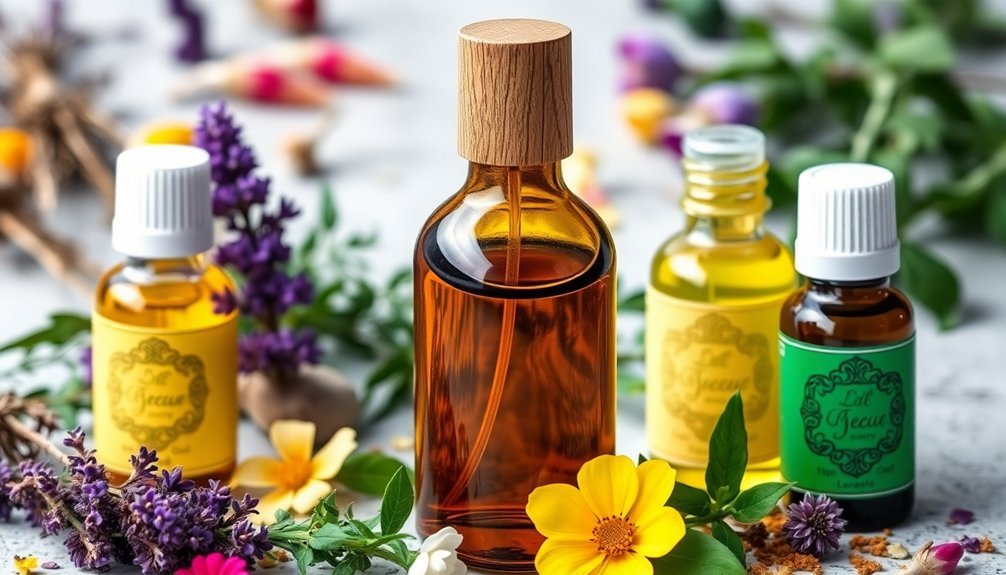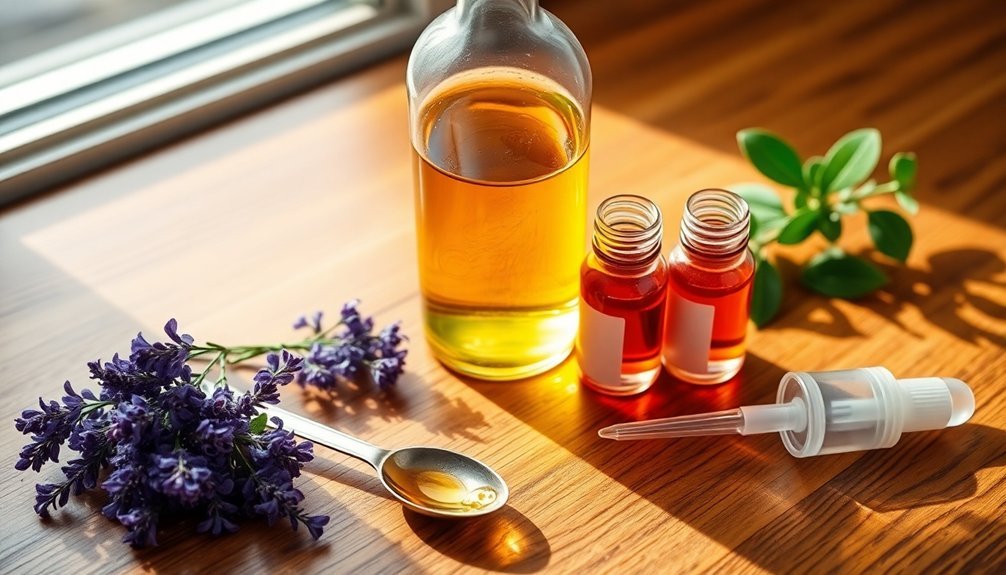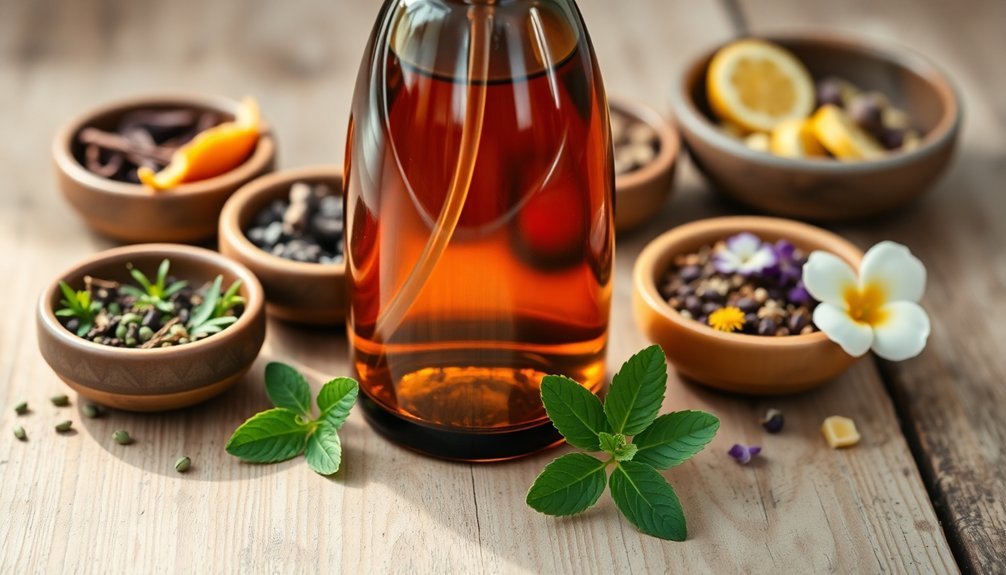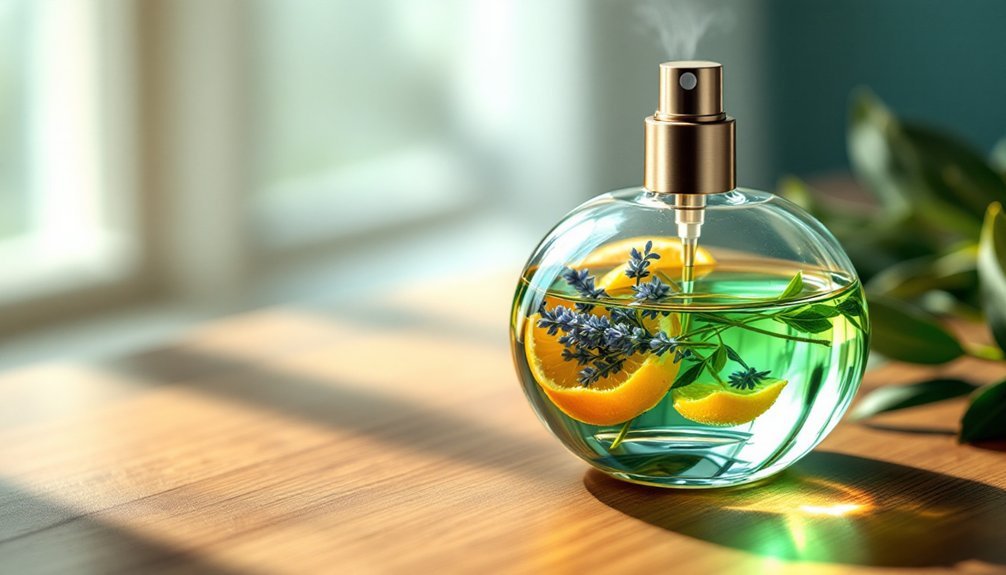Your oil diffuser spray bottle needs three key components for the perfect blend: distilled water as the base, essential oils for fragrance and benefits, and an emulsifier like witch hazel or vodka to help them mix properly. You'll want to use about 30 drops of essential oils total per mixture, combined with 1 oz of emulsifier and 3 oz of water. Follow the right ratios and safety guidelines to access endless aromatherapy possibilities.
Essential Components for Your DIY Spray Bottle

Five key components make up an effective DIY oil diffuser spray.
You'll need witch hazel, which acts as an emulsifier to blend essential oils with water effectively. Essential oils are the heart of your spray, providing therapeutic benefits and delightful scents – popular choices include lavender, lemon, and tea tree oil. For optimal results, use approximately 30 drops total when creating your blend.
For storage, opt for amber or cobalt glass spray bottles. These protect your mixture from UV light degradation, which can compromise the oils' potency.
You'll also want to use distilled water to dilute your oils and fill the bottle, as tap water may contain impurities that affect the spray's quality.
Finally, don't forget to add labels to identify your creation's contents and ingredients – this is especially helpful if you're making multiple blends.
Choosing the Right Base Liquids
With your spray bottle components ready, selecting the right base liquid forms the foundation of your DIY oil diffuser spray.
You'll need to choose between water-based and oil-based solutions, depending on your specific needs.
If you're making a water-based spray, start with distilled water as your primary base. You can add witch hazel or vodka to help disperse the oils properly.
For maximum fragrance potency and stability, consider using an oil-soluble base that can handle up to 18% fragrance load. A quality formulation will ensure no water separation occurs, eliminating the need for shaking before use.
Remember to check that your chosen base and fragrance oils are phthalate-free, paraben-free, and Prop 65 compliant.
You'll want to guarantee your spray is safe for fabrics while avoiding direct skin contact unless specifically formulated as a body spray.
The Perfect Essential Oil Blends

You'll discover endless possibilities when creating your own essential oil blends, from mood-lifting citrus combinations to calming lavender-based formulas.
Whether you're seeking an energizing morning spray with peppermint and lemon or a relaxing bedtime blend with bergamot and chamomile, your diffuser spray can match any wellness goal. Use 8 to 10 drops of essential oils to achieve the perfect strength in your custom blends.
Popular combinations like "Sweet Dreams" or "Fresh Morning" offer proven aromatherapy benefits that you can easily recreate at home with just a few drops of your favorite oils.
Popular Aromatherapy Combinations
Creating the perfect aromatherapy blend requires understanding how different essential oils work together to achieve specific effects.
You'll find that certain combinations can transform your space and mood, whether you're seeking relaxation, energy, cleaner air, or a welcoming atmosphere.
- Combine lavender, geranium, and Roman chamomile for deep relaxation and stress relief
- Mix rosemary and peppermint to boost focus and mental clarity
- Blend lemon, eucalyptus, tea tree, and peppermint to purify your environment
- Create festive scents with cinnamon, juniper, frankincense, and orange
These powerful combinations work because they're carefully balanced to complement each other.
For example, citrus oils pair well with florals for uplifting effects, while mint-based blends excel at energizing and purifying.
You'll notice that certain oils, like lemon and peppermint, appear frequently because they're versatile team players.
DIY Wellness Spray Recipes
Now that you're familiar with popular oil combinations, making your own wellness spray blends opens up endless possibilities for personalized aromatherapy.
Start with a clean glass spray bottle and fill it with distilled water, leaving room for your chosen essential oils and an emulsifier like witch hazel or vodka to help blend the ingredients.
For a calming spray, combine lavender with a touch of vanilla. If you're seeking an energizing blend, mix citrus oils with eucalyptus. Create a natural disinfectant by adding tea tree and thyme oils.
For sensitive skin, consider using gentler hydrosols instead of essential oils. Remember to label your creations with ingredients and dates, and store them in a cool, dark place to maintain their potency.
Safety Guidelines for Mixing Ingredients
When working with essential oils, understanding proper safety guidelines is crucial since these concentrated substances are 50-100 times more potent than their plant sources.
Always mix your ingredients in a well-ventilated area and use proper dilution ratios with carrier oils to prevent skin irritation. Keep all ingredients away from heat sources and direct sunlight to maintain their efficacy.
- Always handle oils with clean hands and avoid contact with eyes, ears, or sensitive areas
- Label your spray bottles clearly with ingredients and usage instructions
- Store mixtures in a cool, dry place using child-proof caps
- Remember that some oils can increase skin sensitivity to UV light
If you experience any adverse reactions, immediately stop use and consult a healthcare professional.
Never ingest essential oils without proper guidance.
Step-by-Step Mixing Process

Your success with homemade diffuser sprays depends on following the correct mixing sequence and measuring precise ratios.
You'll want to start by combining your essential oils with vodka or witch hazel first, ensuring they're thoroughly dispersed before adding distilled water.
The right balance matters – aim for 15-30 drops of essential oils per mixture while maintaining proper proportions of your carrier liquids.
Proper Mixing Order
Creating the perfect oil diffuser spray requires following a specific mixing sequence to guarantee proper emulsification and blending of ingredients.
You'll need to follow a precise order to make certain your oils mix properly with water and maintain their potency.
- Start by adding 1 oz of vodka or witch hazel to your glass container – this emulsifier is essential for proper blending.
- Add 15 drops of your chosen essential oils directly into the emulsifier, allowing them to fully integrate.
- Pour in 3 oz of distilled water, making sure to combine all ingredients thoroughly.
- Give the mixture a final, vigorous shake before each use to maintain proper distribution.
Remember to use only clean glass containers and store your spray in a cool, dark place to preserve the oils' effectiveness.
Blending Ratios Matter
The art of blending essential oils demands precise ratios and careful consideration of each oil's unique properties. You'll want to select oils based on their volatility and how well they work in diffusers. Citrus and conifer oils make excellent choices due to their high volatility, while you should use precious oils like rose or neroli sparingly.
| Oil Type | Volatility | Recommended Ratio |
|---|---|---|
| Citrus | High | 40-50% |
| Conifer | High | 30-40% |
| Floral | Medium | 15-25% |
| Precious | Low | 5-10% |
| Base Notes | Low | 10-15% |
Remember to weigh your oils carefully and store them in glass bottles. For diffuser blends, avoid thick oils like patchouli or sandalwood, as they won't disperse effectively. Instead, focus on lighter oils that will create the desired aromatic impact while maintaining proper safety guidelines.
Storage and Maintenance Tips
Proper storage and maintenance of essential oils greatly extend their lifespan and preserve their therapeutic properties.
You'll want to store your oils in dark glass bottles with airtight seals, keeping them away from direct sunlight and heat sources. Never use plastic containers, as they can compromise the oil's quality.
- Store bottles upright in a cool, dark place or refrigerator
- Label each bottle with the oil's name and date opened
- Replace caps tightly after each use to prevent oxidation
- Organize oils in designated storage boxes or cases with compartments
For your diffuser spray bottles, implement a rotation system to use older oils first.
Keep a separate travel case if you need to transport your oils, and regularly check oil levels to prevent evaporation and contamination.
Remember to maintain consistent temperatures to protect your oils' potency.
Creative Ways to Use Your Spray

While spray bottles are commonly used for aromatherapy, their versatility extends far beyond basic diffusion. You'll find endless possibilities for your oil-infused sprays throughout your home.
Transform your living spaces by creating custom room sprays with uplifting citrus blends or calming lavender mixtures. Spray your linens before bedtime for a peaceful night's sleep, or mist your yoga mat for an enhanced meditation experience.
Elevate your daily rituals with essential oil sprays, from energizing morning mists to soothing bedtime aromatherapy for peaceful slumber.
You can also put your spray bottle to work in practical ways. Use it to freshen up indoor plants, create a natural cleaning solution with vinegar and essential oils, or apply massage oils more effectively.
If you're feeling creative, mix your own body sprays by combining essential oils with witch hazel, or craft a personalized air freshener that suits your mood.
Common Troubleshooting Solutions
When your oil diffuser spray bottle stops working effectively, several common issues can be quickly resolved through basic troubleshooting.
You'll find that most problems stem from nozzle clogs, air blockages, or improper maintenance. A quick soak of the nozzle in warm water and vinegar can often restore function, while ensuring proper space at the bottle's neck prevents airflow issues.
- Disassemble and clean the nozzle with soap and water to remove buildup
- Check for proper airflow by loosening the nozzle slightly
- Avoid overfilling the bottle, which can block the spray mechanism
- Regularly inspect and lubricate the pump for peak performance
If these solutions don't resolve the issue, you might need to replace worn parts or consider upgrading to a higher-quality spray bottle designed specifically for essential oils.
Frequently Asked Questions
Can I Use Tap Water Instead of Distilled Water?
While you can use tap water, it's not recommended as it causes mineral buildup and requires more cleaning. You'll extend your diffuser's life and get better performance by using distilled water instead.
How Many Drops of Essential Oil per Ounce of Base Liquid?
For a standard 2% dilution, you'll need 12 drops of essential oil per ounce of base liquid. However, if you're making facial products, use less (0.2-1.5%), while body products can handle 1.5-3%.
Why Does My Spray Leave Oily Spots on Surfaces?
Your spray's leaving oily spots because you haven't properly emulsified the essential oils with water. To fix this, add witch hazel as an emulsifier and shake well before each use to blend ingredients.
Do Different Colored Spray Bottles Affect the Oil's Potency?
Yes, your spray bottle's color does affect oil potency. Dark amber and blue glass bottles protect essential oils from UV damage, while clear bottles don't. You'll get longer-lasting oils using colored glass containers.
Can I Mix Different Brands of Essential Oils Together?
Yes, you can mix different brands of essential oils together. While the quality may vary between brands, if you're using pure, high-quality oils, they'll blend safely. Just test small amounts first to verify compatibility.





Leave a Reply